The NVIDIA GeForce GTX 650 Ti Review, Feat. Gigabyte, Zotac, & EVGA
by Ryan Smith on October 9, 2012 9:00 AM ESTCompute Performance
As always our final set of real-world benchmarks is composed of a look at compute performance. As we have seen with GTX 680 other Kepler cards, Kepler appears to be significantly less balanced between rendering and compute performance than GF110 or GF114/GF116 were, and as a result compute performance suffers. On the other hand, relative to the GTX 660 the GTX 650 Ti sacrifices a smaller portion of its compute performance than its ROP/L2/memory performance, so this may bode better for computer performance.
Our first compute benchmark comes from Civilization V, which uses DirectCompute to decompress textures on the fly. Civ V includes a sub-benchmark that exclusively tests the speed of their texture decompression algorithm by repeatedly decompressing the textures required for one of the game’s leader scenes. Note that this is a DX11 DirectCompute benchmark.
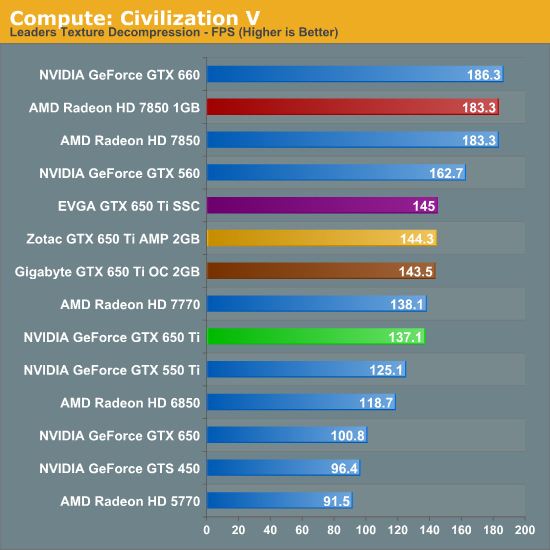
There really isn’t a lot to say here. The GTX 650 Ti is only slightly ahead of the GTX 550 Ti, never mind the GTX 560. Worse, it’s tied with the 7770 and well behind the 7850. Given the nature of the test, with cards on memory busses this small I believe we’ve run into a proxy test for memory bandwidth rather than compute throughput. Which just goes to show that all of that compute throughput is meaningless without the memory bandwidth and cache to feed the best.
Our next benchmark is SmallLuxGPU, the GPU ray tracing branch of the open source LuxRender renderer. We’re now using a development build from the version 2.0 branch, and we’ve moved on to a more complex scene that hopefully will provide a greater challenge to our GPUs.
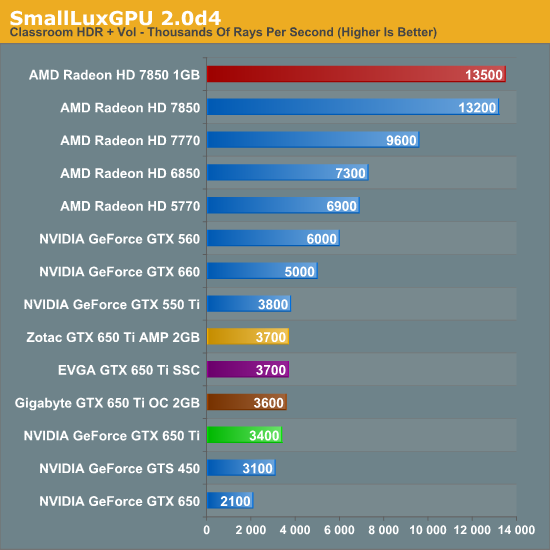
Not surprisingly, the GTX 650 Ti loses to just about everything. SmallLuxGPU’s OpenCL renderer just doesn’t mesh well with Kepler and NVIDIA’s drivers. The resulting lead for the 7850 is nothing short of massive.
For our next benchmark we’re looking at AESEncryptDecrypt, an OpenCL AES encryption routine that AES encrypts/decrypts an 8K x 8K pixel square image file. The results of this benchmark are the average time to encrypt the image over a number of iterations of the AES cypher.
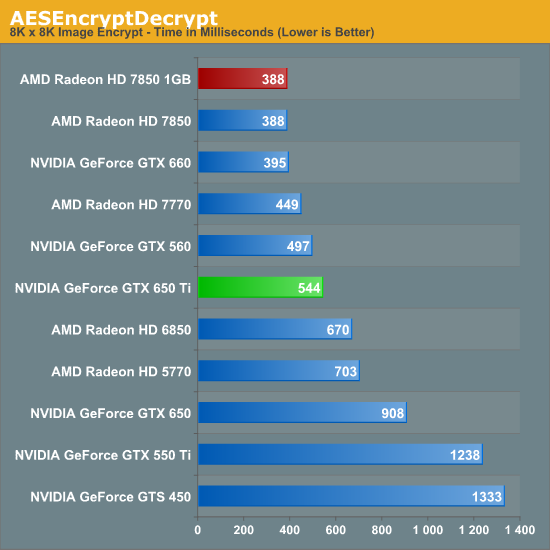
Unlike our previous OpenCL benchmark the GTX 650 Ti’s showing isn’t nearly as bad, but neither is it great. Both the GTX 560 and the 7770 are in the lead, but at least the improvement over the GTX 550 Ti is nothing short of amazing. At times NVIDIA’s problem isn’t where GTX 650 Ti is compared to last-generation cards, but rather it is compared to AMD’s strong Radeon HD 7000 series lineup.
Our fourth benchmark is once again looking at compute shader performance, this time through the Fluid simulation sample in the DirectX SDK. This program simulates the motion and interactions of a 16k particle fluid using a compute shader, with a choice of several different algorithms. In this case we’re using an (O)n^2 nearest neighbor method that is optimized by using shared memory to cache data.
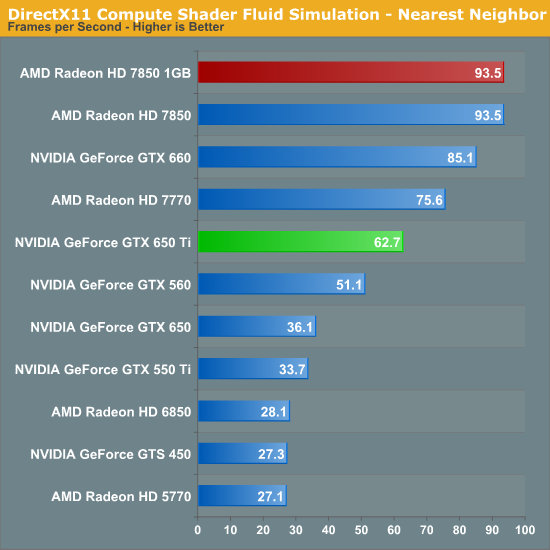
Once more the GTX 650 Ti is in trouble. It can beat the GeForce 500 series, but even the 7770 is faster.
Finally, we’ll take a look at one last benchmark to our compute run with the benchmarkable version of the Folding@Home client. Folding@Home and similar initiatives are still one of the most popular consumer compute workloads, so it’s something NVIDIA wants their GPUs to do well at.
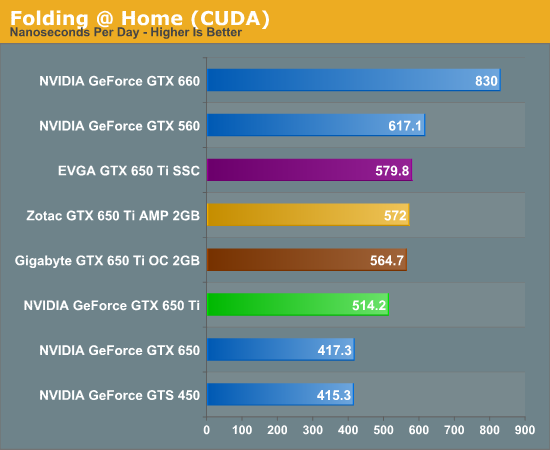
Here’s another case where memory bandwidth and L2 cache appear to be a problem. The GTX 650 Ti is much farther behind the GTX 660 than we would have expected, and even the GTX 560 can take a lead here. On the other hand memory bandwidth bottlenecking isn’t so bad that EVGA’s GTX 650 Ti can’t still take the lead over the other factory overclocked cards.










91 Comments
View All Comments
SodaAnt - Tuesday, October 9, 2012 - link
Why is it that all the manufacturers seem to have the need to put two huge fans and heatsinks on a GPU that only has a TDP of 110W? I mean, I can see having that on a GTX 680 or something, it needs it, but why bother on a low end card? You're just adding price for what is pretty much looks.Shark321 - Tuesday, October 9, 2012 - link
Chip cooling results usually in high noise, so I'm glad they put large heatsinks on the 650 Ti.Blazorthon - Tuesday, October 9, 2012 - link
The 650 Ti has some of the lowest noise and temp results of any graphics card in its class. Those large coolers are definitely beneficial, not that I wouldn't mind seeing some single slot 650 Ti models.MrSpadge - Tuesday, October 9, 2012 - link
"But as it stands today the GTX 650 Ti only makes real sense for buyers who absolutely cannot go over $149"If said buyer can't add another 20$ he probably shouldn't be spending his money on a video card at all.
TheJian - Wednesday, October 10, 2012 - link
You can say that at any price...LOL. Everyone's budget is different. The 660TI really only makes sense for someone who can't spend another $100 on a 670...And then you chime in with your comment again...Both comments are pointless. Ryan puts crap like that in to disparage NV in every article. At $149 it comes with AC3 a AAA title not even released yet, arguably the card is only $120. Unless you think you'll be able to get AC3 for the price of $30 the day it hits. I doubt it. Probably $45-60. So quite a good deal for someone wanting AC3 and only having $150 correct? Pull your head out Ryan. :) Quit making bias comments like this. It's amazing they even give you a AAA title at $150 range.If some kid's been saving his allowance for ages and finally has $150, to replace his old X card it makes total sense. Same for any adult. These cards are for people who don't have $200 etc. No point in making any comment like ryan did.
And at 1680x1050, where most of these users will run this card it doesn't lose much. He keeps quoting cards above where they should run. $100-150 cards are not for 1920x1200. You'll be turning stuff down all day, thus not giving you what the devs wanted you to play. Just like the 660TI/7950 isn't for 2560x1600 either. He keeps using this crap to bash NV cards. This is why he leaves out minimums on almost everything. If he showed those #'s you'd see you can't even play there with these. $300 is for 1920x1200, $450+ is comfortable at above this, $150 is solidly 1680x1050 when MINIMUMS are looked at with max details. If you're not running with all the goodies on, you're not running what the dev wanted you to play. You're missing the FULL experience. 2560x1600 was unplayable on 3/4 games at hardocp on 7950B/660TI. So why talk about those two in the same sentence with 2560x1600? It's DUMB. Two of the games hit 15/17fps on both cards...LOL. That's a freaking slide show FFS. He bashes NV all day over bandwidth for UNPLAYABLE SETTINGS on both cards in those cases. I'd say he doesn't get it, but he does, he knows exactly what he's doing. He loves AMD or they give him something for the love ;) I really don't care who wins at 15fps settings, and neither should ANY of us. They had games where the drop was 100 to 22-26fps on 7950 from max to min...But as long as ryan evades minimums in games he can quote AMD in a better light...LOL.
jtenorj - Wednesday, October 10, 2012 - link
I don't know if experiencing all the developer intended matters as much as simply enjoying the game. The cheapest you can get a "modern" console(not counting the wii) is like 100 bucks for a 360 with a contract for xbox live. If you already have a decent computer from the last few years with crap graphics, you can drop in a 100 dollar(or less) HD7750, overclock it some, and blow away any console's graphics at 1080p by using medium pc settings. If you up the budget a bit to the HD7770 and overclock, you could even manage high settings at 1080p with playable frame rates. If you want to see minimum frame rates, you can go to other sites like hardocp(as mentioned, though it doesn't seem like they have a review up for gtx650ti...yet). Even better is techreport for testing of individual frame times that can catch latency spikes a minimum frame rate measure might miss.justaviking - Wednesday, October 10, 2012 - link
Eventually you have to draw the line somewhere.Start with a budget of $100...
$100? Why not spend $120?
$120? Why not spend $140?
$140? Why not spend $160?
$160? Why not spend $180?
$180? Why not spend $200?
Why not spend $200? Because you started with a $100 budget.
It's not always that you "can't" spend another $20, but most people have to draw the line somewhere. For some people it's $300, others it's $150. Besides, the person spending $150 might have started with a target of $125, and has already "shopped up" to the $150 mark.
This works in the opposite direction too. Why not SAVE $20 and get a cheaper product if it has "almost" the same performance? Then why not save another $20, and so on? Soon you'll be hopelessly underpowered.
That's the sweet agony of shopping for parts like this. There is such a spectrum of price/performance options that you are always near a 2nd or 3rd option. If there was simply one AMD card and one Nvidia card at $100-200-300-400-500 price points, it sure would be a lot easier to go shopping. But what would be the sport in that?
johnsonjohnson - Tuesday, October 9, 2012 - link
Looks like it's gonna have to be the 7850 then. Time to finally retire that 4830...EnzoFX - Tuesday, October 9, 2012 - link
Sorry if I missed it, but this is often not discussed. This is something I cannot stand in lower end cards. Fixed speed fans. They are annoying usually. Then again, I usually swap out the cooler. I'm otherwise all for shorter cards.Ryan Smith - Wednesday, October 10, 2012 - link
Yes, it has variable fan speeds. In fact none of the GeForce 600 cards we've reviewed (including the 640) have a fixed fan speed.